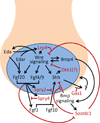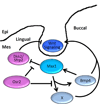Molecular patterning of the mammalian dentition
- PMID: 24355560
- PMCID: PMC3988232
- DOI: 10.1016/j.semcdb.2013.12.003
Molecular patterning of the mammalian dentition
Abstract
Four conserved signaling pathways, including the bone morphogenetic proteins (Bmp), fibroblast growth factors (Fgf), sonic hedgehog (Shh), and wingless-related (Wnt) pathways, are each repeatedly used throughout tooth development. Inactivation of any of these resulted in early tooth developmental arrest in mice. The mutations identified thus far in human patients with tooth agenesis also affect these pathways. Recent studies show that these signaling pathways interact through positive and negative feedback loops to regulate not only morphogenesis of individual teeth but also tooth number, shape, and spatial pattern. Increased activity of each of the Fgf, Shh, and canonical Wnt signaling pathways revitalizes development of the physiologically arrested mouse diastemal tooth germs whereas constitutive activation of canonical Wnt signaling in the dental epithelium is able to induce supernumerary tooth formation even in the absence of Msx1 and Pax9, two transcription factors required for normal tooth development beyond the early bud stage. Bmp4 and Msx1 act in a positive feedback loop to drive sequential tooth formation whereas the Osr2 transcription factor restricts Msx1-mediated expansion of the mesenchymal odontogenic field along both the buccolingual and anteroposterior axes to pattern mouse molar teeth in a single row. Moreover, the ectodermal-specific ectodysplasin (EDA) signaling pathway controls tooth number and tooth shape through regulation of Fgf20 expression in the dental epithelium, whereas Shh suppresses Wnt signaling through a negative feedback loop to regulate spatial patterning of teeth. In this article, we attempt to integrate these exciting findings in the understanding of the molecular networks regulating tooth development and patterning.
Keywords: Dentition; Msx1; Osr2; Revitalization; Signaling network; Tooth development.
Copyright © 2013 Elsevier Ltd. All rights reserved.
Figures





Similar articles
-
Bmp4-Msx1 signaling and Osr2 control tooth organogenesis through antagonistic regulation of secreted Wnt antagonists.Dev Biol. 2016 Dec 1;420(1):110-119. doi: 10.1016/j.ydbio.2016.10.001. Epub 2016 Oct 3. Dev Biol. 2016. PMID: 27713059 Free PMC article.
-
Roles of Bmp4 during tooth morphogenesis and sequential tooth formation.Development. 2013 Jan 15;140(2):423-32. doi: 10.1242/dev.081927. Development. 2013. PMID: 23250216 Free PMC article.
-
Deletion of Osr2 Partially Rescues Tooth Development in Runx2 Mutant Mice.J Dent Res. 2015 Aug;94(8):1113-9. doi: 10.1177/0022034515583673. Epub 2015 Apr 27. J Dent Res. 2015. PMID: 25916343 Free PMC article.
-
Genes affecting tooth morphogenesis.Orthod Craniofac Res. 2007 Aug;10(3):105-13. doi: 10.1111/j.1601-6343.2007.00395.x. Orthod Craniofac Res. 2007. Corrected and republished in: Orthod Craniofac Res. 2007 Nov;10(4):237-44. doi: 10.1111/j.1601-6343.2007.00407.x. PMID: 17651126 Corrected and republished. Review.
-
Genes affecting tooth morphogenesis.Orthod Craniofac Res. 2007 Nov;10(4):237-44. doi: 10.1111/j.1601-6343.2007.00407.x. Orthod Craniofac Res. 2007. PMID: 17973693 Review.
Cited by
-
FAM20B-catalyzed glycosaminoglycans control murine tooth number by restricting FGFR2b signaling.BMC Biol. 2020 Jul 14;18(1):87. doi: 10.1186/s12915-020-00813-4. BMC Biol. 2020. PMID: 32664967 Free PMC article.
-
Craniofacial malformations and their association with brain development: the importance of a multidisciplinary approach for treatment.Odontology. 2020 Jan;108(1):1-15. doi: 10.1007/s10266-019-00433-7. Epub 2019 Jun 6. Odontology. 2020. PMID: 31172336 Review.
-
Alteration of Exon Definition Causes Amelogenesis Imperfecta.J Dent Res. 2020 Apr;99(4):410-418. doi: 10.1177/0022034520901708. Epub 2020 Jan 30. J Dent Res. 2020. PMID: 31999931 Free PMC article.
-
A Novel AXIN2 Missense Mutation Is Associated with Non-Syndromic Oligodontia.PLoS One. 2015 Sep 25;10(9):e0138221. doi: 10.1371/journal.pone.0138221. eCollection 2015. PLoS One. 2015. PMID: 26406231 Free PMC article. Clinical Trial.
-
Early development and replacement of the stickleback dentition.J Morphol. 2016 Aug;277(8):1072-83. doi: 10.1002/jmor.20557. Epub 2016 May 3. J Morphol. 2016. PMID: 27145214 Free PMC article.
References
-
- Pires-DaSilva A, Sommer RJ. The evolution of signaling pathways in animal development. Nat Genet. 2003;4:39–49. - PubMed
-
- Pispa J, Thesleff I. Mechanisms of ectodermal organogenesis. Dev Biol. 2003;262:195–205. - PubMed
-
- Thesleff I, Sharpe P. Signalling networks regulating dental development. Mech Dev. 1997;67:111–123. - PubMed
-
- Jernvall J, Thesleff I. Reiterative signaling and patterning during mammalian tooth morphogenesis. Mech Dev. 2000;92:19–29. - PubMed
-
- Tucker AS, Sharpe PT. The cutting-edge of mammalian development, how the embryo makes teeth. Nat Rev Genet. 2004;5:499–508. - PubMed
Publication types
MeSH terms
Grants and funding
LinkOut - more resources
Full Text Sources
Other Literature Sources

